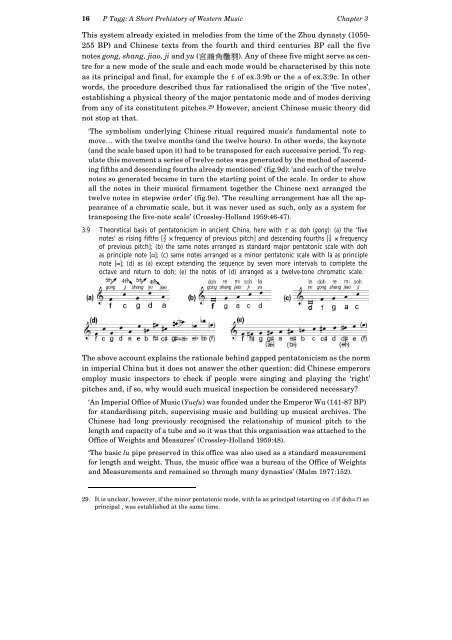A Short Prehistory of Western Music, Chapter 3
A Short Prehistory of Western Music, Chapter 3
A Short Prehistory of Western Music, Chapter 3
You also want an ePaper? Increase the reach of your titles
YUMPU automatically turns print PDFs into web optimized ePapers that Google loves.
16 P Tagg: A <strong>Short</strong> <strong>Prehistory</strong> <strong>of</strong> <strong>Western</strong> <strong>Music</strong> <strong>Chapter</strong> 3<br />
This system already existed in melodies from the time <strong>of</strong> the Zhou dynasty (1050-<br />
255 BP) and Chinese texts from the fourth and third centuries BP call the five<br />
notes gong, shang, jiao, ji and yu ( ). Any <strong>of</strong> these five might serve as centre<br />
for a new mode <strong>of</strong> the scale and each mode would be characterised by this note<br />
as its principal and final, for example the f <strong>of</strong> ex.3:9b or the a <strong>of</strong> ex.3:9c. In other<br />
words, the procedure described thus far rationalised the origin <strong>of</strong> the ‘five notes’,<br />
establishing a physical theory <strong>of</strong> the major pentatonic mode and <strong>of</strong> modes deriving<br />
from any <strong>of</strong> its constitutent pitches. 29 However, ancient Chinese music theory did<br />
not stop at that.<br />
‘The symbolism underlying Chinese ritual required music’s fundamental note to<br />
move… with the twelve months (and the twelve hours). In other words, the keynote<br />
(and the scale based upon it) had to be transposed for each successive period. To regulate<br />
this movement a series <strong>of</strong> twelve notes was generated by the method <strong>of</strong> ascending<br />
fifths and descending fourths already mentioned’ (fig.9d): ‘and each <strong>of</strong> the twelve<br />
notes so generated became in turn the starting point <strong>of</strong> the scale. In order to show<br />
all the notes in their musical firmament together the Chinese next arranged the<br />
twelve notes in stepwise order’ (fig.9e). ‘The resulting arrangement has all the appearance<br />
<strong>of</strong> a chromatic scale, but it was never used as such, only as a system for<br />
transposing the five-note scale’ (Crossley-Holland 1959:46-47).<br />
3:9 Theoretical basis <strong>of</strong> pentatonicism in ancient China, here with f as doh (gong): (a) the ‘five<br />
notes’ as rising fifths [G × frequency <strong>of</strong> previous pitch] and descending fourths [H × frequency<br />
<strong>of</strong> previous pitch]; (b) the same notes arranged as standard major pentatonic scale with doh<br />
as principle note []; (c) same notes arranged as a minor pentatonic scale with la as principle<br />
note []; (d) as (a) except extending the sequence by seven more intervals to complete the<br />
octave and return to doh; (e) the notes <strong>of</strong> (d) arranged as a twelve-tone chromatic scale.<br />
The above account explains the rationale behind gapped pentatonicism as the norm<br />
in imperial China but it does not answer the other question: did Chinese emperors<br />
employ music inspectors to check if people were singing and playing the ‘right’<br />
pitches and, if so, why would such musical inspection be considered necessary?<br />
‘An Imperial Office <strong>of</strong> <strong>Music</strong> (Yuefu) was founded under the Emperor Wu (141-87 BP)<br />
for standardising pitch, supervising music and building up musical archives. The<br />
Chinese had long previously recognised the relationship <strong>of</strong> musical pitch to the<br />
length and capacity <strong>of</strong> a tube and so it was that this organisation was attached to the<br />
Office <strong>of</strong> Weights and Measures’ (Crossley-Holland 1959:48).<br />
‘The basic lu pipe preserved in this <strong>of</strong>fice was also used as a standard measurement<br />
for length and weight. Thus, the music <strong>of</strong>fice was a bureau <strong>of</strong> the Office <strong>of</strong> Weights<br />
and Measurements and remained so through many dynasties’ (Malm 1977:152).<br />
29. It is unclear, however, if the minor pentatonic mode, with la as principal (starting on d if doh=f) as<br />
principal , was established at the same time.














